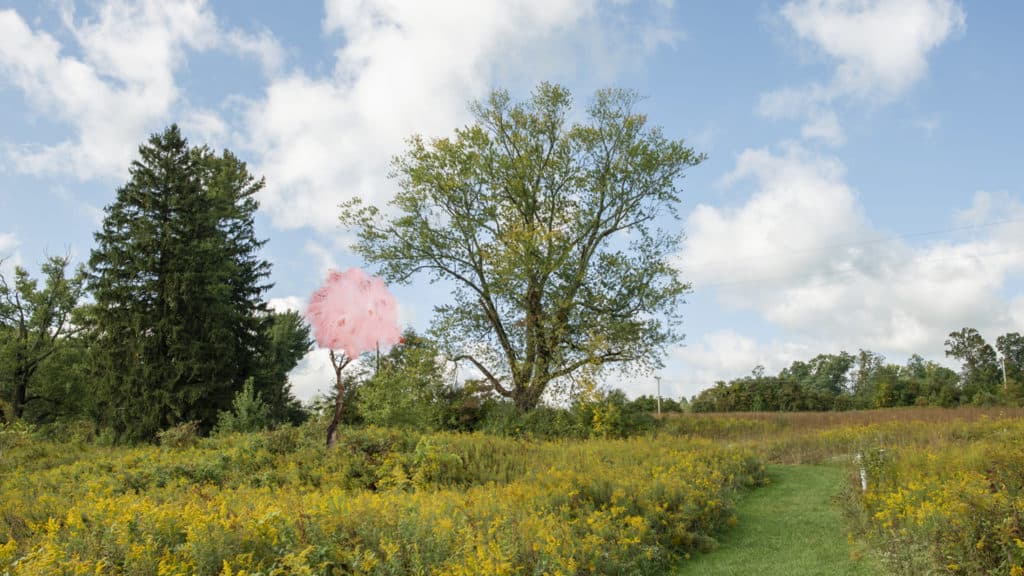reintroducing a native tree species.
April 2022 – Today, Natural Lands announced the successful cultivation and restoration of Cupressus truffulus, commonly known as truffula tree, to southeastern Pennsylvania. Thought to be extinct in the wild, Natural Lands’ horticulturists have been propagating and planting the truffula tree, in secret, for nearly a decade.
This restoration began 2012 with the purchase and propagation of the trees in a greenhouse by experts at Natural Lands. Truffula trees are slow growing; reaching their full height of 60 to 80 feet can take a century. In the cypress family, the trees take on interesting shapes as they mature. In spring, their needled branches develop distinctive, feathery-soft, pink bracts. Small flower clusters in the axils produce abundant fruit when germinated under just the right conditions.
“The flowers require pollination by the candy tuft butterfly, whose mouth parts are perfectly adapted to Cupressus truffulus’ flower shape,” said Ethan Kauffman, director of Stoneleigh: a natural garden, which is owned and managed by Natural Lands. Kauffman oversaw the team of horticulturists working on the project. “It took years for our team to figure out how to replicate this precise pollination effect.”
After the seedlings were nurtured in a greenhouse, plantings were done in secret on remote parts of Natural Lands’ nature preserves. These locations were only known by key staff and a few trusted volunteers.
Said Mae Axelrod, media relations manager at Natural Lands, “Because of the risk of foraging and theft, we had to be careful to conceal the location of the trees.” But this secret was difficult to keep, especially with the knowledgeable volunteers Natural Lands relied on for planting. “There were many knowing glances,” said Axelrod, “but everyone understood the danger of sharing the location of these rare trees, especially while they were vulnerable seedlings.”
Even now that the trees are too large for transport, the locations of the trees are not publicized. Truffula trees were harvested to extinction in the 1970’s and the danger of poaching remains. The fibers of the truffla are softer than silk and very strong, and their vibrant colors were prized in the garment industry. The trees were used to make pillows, sheets, curtains, bicycle seats, and the popular Thneeds, which were known by their tagline “what everyone needs.” This unregulated harvest, combined with the trees’ slow growth, led to its extinction.
Without the truffula to shade their growth, grickle-grass has been taking over the habitat where the trees once stood. While grickle-grass is native, its vigorous growth creates habitat for ticks and, when dry, can lead to a heightened fire risk. In the shade of the towering truffula trees, ground cover grickle-grass was used by Swomee-Swans and other ground-nesting birds who laid their large eggs among the fluffy grasses in wetlands. However, in sunnier conditions, grickle-grass–once a single note in an eco-chorus–has become aggressive, dominating the landscape and pushing out other species.
The most dramatic ripple impact of the truffula tree’s extinction was on the Bar-ba-loots, who depended on the truffula fruits for their suits. As the population of trees dwindled, so did the population of Bar-ba-loots, until they too disappeared.
Truffula seeds were sourced from a private collection. Ten years ago, Natural Lands President Oliver Bass purchased them from a seller who insisted on a very specific price.
“Typically, we rely on the support of our members, donors, and public grants to make important purchases for conservation,” said Bass. “But in this case the seller wished for 15 cents, a nail, and the shell of a great-great-great grandfather snail. I found the 15 cents in the couch cushions of our breakroom and picked up a nail from the workshop in the barn at Hildacy Preserve. Of course, like everyone, I’ve got about 20 grandfather shells just clattering around my junk drawer, but a great-great-great grandfather snail shell was harder to find. We asked the kids in the nature camp at Crow’s Nest to keep an eye out, and one day in August they found one under a mushroom. Then I headed off to the far end of town, paid the fee, and was provided with seeds for the truffula trees. I did have to listen to a rather long story first via Whisper-ma-Phone, but in the end, it was worth it for those seeds. After all, the trees have no tongues, so it’s Natural Lands mission to speak for them, and the entire network of plants and animals in this diverse habitat.”
Happy April 1!

Photo: Mae Axelrod
With deepest love to Dr. Seuss and his beloved character, The Lorax, who inspired so many of us to care for nature. And to everyone who cares, who cares a whole lot, so that things can get better.
If this gave you a giggle and if you want to be someone who, like the Lorax, cares a whole lot, consider supporting us. We do not grow truffula trees, but we helped bring the Bald Eagle back to this region. Our work supports the wide world of insects, plants, and animals native to our region—including humans who enjoy nature.
If you care a whole lot, become a member. A donation of $50 is a lot easier to find than a grandfather shell, and will have a bigger impact on our region.
